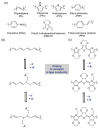Conducting polymer-based sensors for food and drug analysis
- PMID: 35649139
- PMCID: PMC9931017
- DOI: 10.38212/2224-6614.3374
Conducting polymer-based sensors for food and drug analysis
Abstract
Conducting polymers (CPs) are a category of polymeric materials with conjugated main chains. The characteristic electrical and optical properties of CPs can be fine-tuned through controlling the doping states of CPs. Because of their long-term stability in water, CPs have been demonstrated as electroactive biointerfaces and electrode materials especially in aqueous environments. Serving as multifunctional interfaces and organic electrodes for the integration bioelectronics and devices, CPs have been studied and applied in various biological applications. This paper provides a review of conducting polymer-based electrochemical sensors, particularly those used in biological fields. General conducting polymers and derivatives and their main electrochemical sensing platforms with different design of devices are introduced. Cyclic voltammetry, differential pulse voltammetry, chronoamperometry, electrochemical impedance spectroscopy, and quartz crystal microbalance methods and their features are then explored as detection methods for the analysis of drugs and food. To enhance the sensitivity and lower the detection limit of sensing platforms, various CP-based nanocomposites have been designed and developed. Although the electrodes made of CP-based nanocomposites usually outperform those made of pristine CPs, more systematic studies are required to provide insights into the design of nanocomposite-based electrodes. More applications of CP-based sensors for advanced food and drug analyses are expected.
Conflict of interest statement
The authors have no conflicts of interest.
Figures




References
-
- MacDiarmid AG, Epstein AJ. The concept of secondary doping as applied to polyaniline. Synth Met. 1994;65:103–16.
-
- Snook GA, Kao P, Best AS. Conducting-polymer-based supercapacitor devices and electrodes. J Power Sources. 2011;196:1–12.
-
- Warren LF, Walker JA, Anderson DP, Rhodes CG, Buckley LJ. A study of conducting polymer morphology: the effect of dopant anions upon order. J Electrochem Soc. 1989;136:2286–95.
-
- Bai H, Shi G. Gas sensors based on conducting polymers. Sensors. 2007:7.
Publication types
MeSH terms
Substances
LinkOut - more resources
Full Text Sources
Miscellaneous
